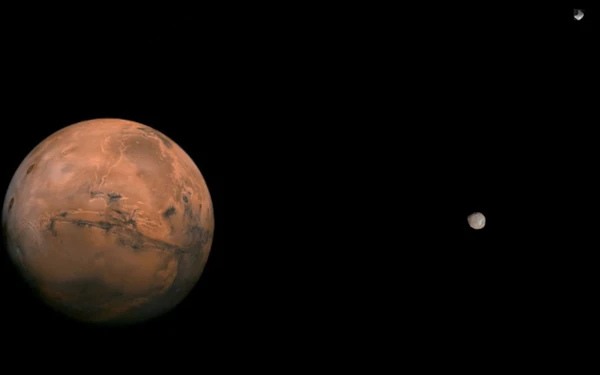
Unlike the multiple-moon systems of gas giants, Mars has only two small natural satellites: Phobos and Deimos. Discovered in 1877 by Asaph Hall (1829–1907) at the Washington Naval Observatory, these irregular bodies have puzzled planetary scientists ever since. Measuring 27×22×18 km and 15×12×10 km respectively, they resemble asteroids more than "classic" moons formed by accretion around their planet.
| Parameter | Phobos | Deimos | Comparison |
|---|---|---|---|
| Dimensions (km) | 27.0 × 21.6 × 18.8 | 15.0 × 12.2 × 10.4 | Phobos is 2.7 times more voluminous than Deimos |
| Mass (×1015 kg) | 10.659 | 1.476 | Phobos is 7.2 times more massive |
| Density (g/cm3) | 1.876 ± 0.020 | 1.471 ± 0.030 | Phobos is 27% denser—suggests different composition |
| Distance from Mars (km) | 9,376 (6,000 km above surface) | 23,460 | Deimos is 2.5 times farther |
| Orbital period | 7h 39m 14s | 30h 18m 43s | Phobos completes 3 orbits in one Martian day |
| Rotation period | 7h 39m 14s (synchronous) | 30h 18m 43s (synchronous) | Both moons always show the same face to Mars |
| Albedo | 0.071 | 0.068 | Very dark surfaces, similar to D-type asteroids |
| Surface temperature | -4°C to -112°C | -40°C to -130°C | Phobos is slightly warmer due to proximity to Mars |
| Surface gravity (m/s2) | 0.0057 | 0.003 | A 70 kg human would weigh ~400 g on Phobos |
| Escape velocity (m/s) | 11.39 | 5.56 | A vigorous jump could eject an astronaut from Deimos |
| Main crater | Stickney (9 km, 40% of diameter) | No dominant crater (max. 2.3 km) | The Stickney impact nearly destroyed Phobos |
| Presumed composition | Mix of carbonaceous rocks and regolith (100–200 m thick) | Similar but with more hydrated materials | Spectra resemble D/T-type asteroids |
| Future fate | Disintegration by tidal forces in 30–50 Ma | Slow escape from Martian orbit | Phobos will form a ring around Mars |
The study of Mars’ moons has seen several key milestones:
These moons play a far greater scientific role than their size suggests:
Their study could resolve several mysteries:
As Tomohiro Usui (1975–), MMX project scientist, explains: “Phobos is a time capsule preserving primitive solar system materials while collecting Martian dust ejected by meteorite impacts over billions of years.”
Phobos’ fate is particularly dramatic. Calculations by Benjamin Black (1983–) and Tushar Mittal (1989–) (UC Berkeley, 2023) show:
This catastrophic scenario offers a unique chance to study planetary ring formation in real time—a process never before observed in our solar system.